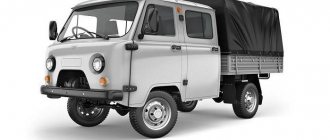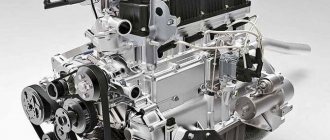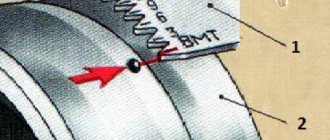In 2010, the Gorky Automobile Plant began producing light-duty Gazelle-Business trucks, some of which are equipped with Cummins ISF2.8 turbocharged diesel engines, which are deservedly popular. These motors from an American company are manufactured in China and are highly reliable and economical. Until the end of 1912, they corresponded to the Euro-3 class, then they began to be equipped with catalytic converters and moved to Euro-4.
Cummins ISF2.8 engine installed on the Gazelle
When the production of the new Gazelle Next model began in 2013, the Cummins diesel remained in its line of standard engines, which confirms its merits. Selection of supplier - Cummins Inc. - dictated by the reputation of the company, whose products have proven themselves well in international markets. According to statistics, every tenth diesel car in the world is equipped with an engine from this company.
In Russia, Cummins engines were previously installed on some brands of cars, and there was already a network of technical centers with experience in servicing them. And the company offered supplies at affordable prices. All these factors determined the choice.
Adaptation of “Gazelle Business” and “Gazelle Next” for Cummins ISF2.8
Compared to the standard UMZ-4216.70 engine, the American diesel engine has significantly greater torque and a different thermal regime.
The standard engine of the gazelle UMZ-4216.70
Because of this, the design of a number of vehicle components had to be redesigned:
- Cooling system. An electric intake air heater has appeared (used if necessary). It also reduces the emission of white smoke in the first minutes after the engine starts running. A new fan with support was installed, hoses were replaced.
- Transmission. The manual transmission is housed in a more powerful crankcase, for smooth movement of the car the gear ratios have become different, the shafts and gears are made of steel with increased strength. Hoerbirger synchronizers and SKF bearings are installed. The clutch has acquired an additional idle damper.
- Steering. A ZF power steering pump and a V-belt pulley are used.
- Exhaust system. An updated receiving tube and vibration compensator were installed.
- Electrical equipment. The package includes a larger capacity battery (75 Ah). A new control unit has appeared that remains operational in severe frosts.
- Fuel system. The possibility of manual pumping of fuel is provided.
- Minibuses are equipped with an autonomous Eberspacher interior heater (for other models this is an option).
Adaptation of Gazelle Next is much simpler. In the manual transmission, the gears have become wider, additional bearings have been added, and the synchronizers have changed. The rear axle is made of high-strength steel. The package included a ZF Sachs clutch, and the diameter of the driven disc increased (280 instead of 240 mm).
GAZelle Next engines. Official fuel consumption per 100 km.
- turbodiesel, manual transmission, 120 horsepower, torque 270 N/m. The working volume is 2.8 liters, the maximum speed is 130 km/h, the fuel tank capacity is 70 liters.
- Petrol UMP, 2.9 l, 105 l. With.
GAZelle-Next 2.7 petrol
Since 2014, GAZelle-Next vehicles have been equipped with a UMZ A274 EvoTech 4-cylinder gasoline injection engine of Euro-4 standard. It produces 107 PS of power and has a peak torque of 220 Nm and is mated to a 5-speed manual transmission.
Gazelle Next 2.7 gas
The production of Gazelle Next cars, equipped with a UMZ A2755 EvoTech gas-gasoline 4-cylinder engine of Euro-5 standard, began in 2014 simultaneously with the start of production of the gasoline version. Immediately after its appearance, this engine began to enjoy popularity - with the same power as the gasoline version, a gas engine engine is an order of magnitude more economical, especially in dense city traffic. It works with a 5-speed manual transmission and is capable of developing a power of 107 hp and a torque of 220 Nm.
Description and characteristics of the engine
Cummins Inc's priority has been and remains to support the following features of its products:
- High reliability and performance.
- Compliance with environmental standards.
Cummins ISF2.8 engine on the Gazelle Next truck
- Low operating costs.
- Small size and weight.
“Gazelles” are equipped with Cummins ISF2.8 engines, which fully possess these qualities and are perfect for light-duty trucks weighing up to 3.5 tons. The cars are in demand, despite the higher price than their gasoline-powered counterparts. Due to the low operating costs of a diesel engine, the difference in cost quickly pays off.
What is an engine? This is a 4-cylinder in-line turbocharged diesel engine for the Gazelle. It is unpretentious in terms of fuel quality and has good maintainability. The manufacturer claims a resource of 500 thousand kilometers. The cylinder block and cylinder head are made of high-strength gray cast iron, the liners are milled, have medium fixation, and can be replaced in case of wear or damage. The pistons are composite: the skirt is aluminum, and its upper part is made of an alloy that is resistant to high temperatures.
Cummins ISF2.8 engine cylinder block
The crankshaft is made of malleable gray cast iron and is balanced. Its necks are cemented, have high surface strength and cannot be processed; the shaft can only be replaced as a whole. Repair inserts are also not available. The camshaft is located in the cylinder head, the drive is chain driven with a hydraulic tensioner and two shoes. The cylinder head gasket consists of several steel sheets and does not require tightening.
Conclusion
As you can see, the new generation of Gazelles labeled Next has received new power units that are even more reliable and powerful than their predecessors. Thus, the car received a diesel engine produced by Cummins and a gasoline analogue of the UMZ EvoTech 2.7.
Sources
- https://TraktorBook.com/gazel-nekst/
- https://avtodvigateli.com/marki/gazel-nekst.html
- https://dvsoff.ru/tip/gazel-nekst-dvigatel
- https://next-gazel.ru/dvigatel-gazel-nekst
- https://avtodvigateli.com/marki/cummins-gazel.html
- https://AvtomobilGaz.ru/furgony/gazel/gazel-next-s-dvigatelem-cummins.html
- https://AvtoMera.com/gaz/gazel-nekst-rasxod-topliva-na-100-km-dvigateli-cummins-umz-evotech/
- https://AvtoZhor.com/gazel-nekst-rasxod-topliva/
- https://RasxodTopliva.ru/13-gazel-nekst.html
- https://lifespeaker.ru/benzin-ili-dizel-s-kakim-dvigatelem-kupit-gazeli-nekst.html
- https://mostat-gruzovik.ru/a214394-vse-dvigateli-gazel.html
- https://raskhod.ru/gaz/rashod-topliva-gaz-gazel-next
- https://arendavlg.com/gazel/harakteristiki-i-otzyvy-o-gazeli-nekst-s-benzinovym-dvigatelem-evotech.html
- https://AvtomobilGaz.ru/furgony/gazel/gazel-next-benzinoviy-dvigatel-evotech.html
Exploitation
In order for a Gazelle with a Cummins ISF2.8 engine to serve for a long time and without breakdowns, you must follow some rules. One of the most important is to fill up with fuel that is appropriate for the season. Before starting the engine, check the oil and coolant levels. Make sure that the lighting and alarm devices, the windshield wiper and the windshield washer system are in working order. Before driving, check the condition of the wheels.
Start the engine (use preheater if necessary) and allow it to warm up. For some time after starting to drive, you should drive in lower gears without heavy loads so that the oil in the manual transmission and rear axle warms up. This is especially important at low air temperatures. You can gradually increase the load and use all gears.
Be careful when driving through deep puddles and immediately after washing your car. If water gets into the wheel brakes, their effectiveness drops sharply. In this case, you should move at low speed and slow down to heat the mechanism and evaporate the water.
To avoid unnecessary loads on the engine and transmission, you should not drive for a long time at low engine speeds (less than 1500 rpm), it is better to switch to a lower gear. For the same reason, it is desirable to move smoothly, without sudden acceleration and braking.
After completing your trip, do not stop the engine immediately, let it idle for a minute or two to evenly reduce the temperature of the engine and turbocharger. This is especially important after high loads of movement.
Adjusting your driving style
The fuel consumption rate on the Gazelle Next (diesel) can go up if the driver prefers a harsh driving style - sudden starts and braking, sliding, skidding, driving onto the lawn, etc. Change your driving style, and then you can save additional money. Compliance with traffic rules has not harmed anyone so far.
You should not drive around at low speeds - such maneuvers sharply increase the average fuel consumption of the Gazelle Next. Speed is one of the factors affecting diesel consumption. An effective but risky step to save on fuel is to turn off the turbine of a diesel engine. And a few more rules:
- switching to gas will allow you to reduce the cost of Gazelle Next fuel consumption by 100 km;
- The gas consumption rate is not very different from liters of gasoline or diesel, but the savings are significant, because gasoline and diesel are much more expensive, it is especially profitable to drive on methane, even though we have few such gas stations in our country;
- savings with the help of gas equipment do not begin to be felt immediately, but gradually, during the period of debt for installing a gas engine, which more than pays off in a few months.
Diesel Communis
In the distant 20s of the last century, the American company Communis began producing diesel generators for agriculture. Due to the fact that their units served for decades and did not break down, the company continued to develop, and already every tenth diesel engine in the world is produced with the Communis emblem. This should say a lot about the reliability of the unit.
The American engine appeared on the Russian market in 2011. Over eight years, all services and auto repair shops have gone through it hundreds of times, so there will be no problems with repairs either, and spare parts are sold on the car market.
In the diesel Gazelle Next, fuel consumption is 2 liters per 100 kilometers less than Evotech. And its resource is more than 100 thousand kilometers. If you calculate costs over 5-10 years, then the benefit is clearly for diesel. Even fuel at gas stations is cheaper. Large enterprises, when purchasing large volumes of diesel, save up to 50 thousand rubles per year.
Some owners criticize diesel engines for frequent repairs. In them, combustion products are formed more intensively, which is why the walls of the parts become coated with plaque many times faster. To avoid this problem, manufacturers advise using only high-quality diesel fuel, or using cleaning additives.
Comparison
Having analyzed the information above, we can come to the conclusion that:
- The gasoline engine in the Gazelle Next will allow you not to worry about many problems, such as environmental standards, air temperature and the position of the car.
- The diesel engine is more economical and powerful to use, but at the same time, more demanding.
Diesel will be an ideal solution for large corporations and agricultural enterprises, or private owners living in the southern part of Russia.
Evotech modification
Owners of gasoline engines can use LPG (gas cylinder equipment). To do this, not fuel vapors, but a propane-butane mixture are supplied to the engine. It is several times cheaper not only than gasoline, but also diesel. The savings in fuel consumption on Gazelle Next in this case will be 70%. At the same time, many Russian drivers do not trust gas, since when installing it it is necessary to strictly observe safety precautions.
Troubleshooting
Most problems arise due to overloads, the use of low-quality fuel, oils and coolants, untimely maintenance or illiterate operation. Reviews from owners often contain complaints about poor performance of fuel equipment, especially injectors. To prevent problems, it is necessary to change filters and oil on time, and fill up diesel fuel at reliable gas stations (unfortunately, there are cases of fuel being diluted with water). If problems occur frequently, you can add an additional separator to the fuel system.
This is what the injectors look like for Cummins isf 2.8.
Signs of injector malfunction:
- Black smoke from the muffler;
- Knock in the engine;
- “Swimming” speed at idle;
- Power reduction;
- Difficulty starting the engine.
You cannot operate an engine with faulty injectors; this can lead to serious consequences. If more fuel enters the cylinders, the piston and valves begin to melt; if less, the engine is difficult or impossible to start, and power drops significantly.
Despite all the filters, there may be water in the fuel. In this case, problems arise with the fuel pump. Metal shavings are supplied along with diesel fuel, which leads to damage to the nozzles. Before replacing, you should determine the cause of the malfunction and, if necessary, flush the entire fuel system. Another common malfunction is the pipe through which oil from the turbocharger drains bursts.
This occurs due to vibration and leads to rapid loss of oil. The Gorky Automobile Plant admitted the mistake in the design and announced the free installation of a special bracket to protect the tube. If your car does not have this, contact any official GAZ dealer. Before that, you will have to check whether oil leaks have appeared on the drain tube.
Sometimes malfunctions occur in the turbine of the Holset HE211W compressor. The reasons may be a lack of oil, frequent operation at extreme conditions, overheating or accidental damage to the compressor. Signs include bluish smoke and the characteristic smell of burnt oil. The turbine should be replaced with an original one; if you use another one, new problems may arise. Another problem is that the gap between the radiator and the intercooler is too small, which becomes clogged with dirt, leaves and all sorts of debris.
The gap between the radiator and intercooler of the Cummins isf 2.8 engine.
Clean it regularly, otherwise the engine may overheat.
A good solution would be to increase the distance between the radiator and intercooler. A dirty air filter causes additional wear on the piston rings, which are abraded by dust trapped in the cylinders as an abrasive. In this case, you should change the filter more often than indicated in the instruction manual. Heavy loads on the engine sometimes lead to rotation of the liners and crankshaft. Seizures form on the journals, and defective parts will have to be replaced. If this happens, try to purchase original spare parts. Reviews mention frequent contamination of the electronic gas pedal contacts. Signs of a malfunction include poor response to changes in pedal position and jerking when driving. Remove the pedal and clean the contacts with alcohol.
Reasons for popularity
Gazelle Next has gained popularity among large business owners for several reasons:
- efficiency, low consumption of fuel materials;
- simplicity and conciseness in use;
- the vehicle's endurance and its ability to endure long raids over various types of terrain without damage;
- high level of driving comfort.
Functional features
Cummins, which is under the hood of the diesel version of the Gazelle Next, not only provides optimal real fuel consumption for the Gazelle Next, but also makes the car a universal vehicle. The engine capacity of the Gazelle Next is 2.8 liters
. This volume cannot be called large, but this makes it quite productive with minimal fuel consumption. As you know, the size of the engine determines its power and the amount of fuel consumption.
The creators made sure that the car’s engine was recognized abroad by many companies that collaborate with European companies, which makes the Gazelle Next even more popular. The engine standard is called Euro-4.
Basic Techniques
- replacing the air filter. This element of the car’s structure significantly affects the level of gasoline consumption on the highway;
- therefore, when the air filter deteriorates, the average fuel consumption of the Gazelle Next increases;
- just install a new air filter according to the instructions, and Next's fuel consumption will decrease by 10-15%.
The use of high viscosity oil, which optimizes engine performance and protects it from unwanted loads, is not in short supply in the automotive market, so you can freely reduce diesel consumption in Gazelle Next by about 10%. Over-inflated tires.
This simple technique allows you to further save on fuel consumption.
The main thing is not to overdo it - the tires should be overinflated by 0.3 atm, and in no case more. In addition, if there is a danger of damaging the suspension on your car, you need to control this element of the car’s structure when you drive on overinflated tires.
Adjustment of valves
Adjusting valves on a Cummins isf 2.8 engine
This is an important job that some drivers who have experience adjusting gasoline engines are for some reason afraid to do on an American diesel engine. But there is nothing particularly complicated; even an inexperienced driver can cope with the adjustment. During operation, the gaps between the valves and rocker arms gradually increase. But too large gaps lead to increased fuel consumption, decreased power and other unpleasant consequences.
A sign of a problem is a characteristic knocking sound when the engine is running. For normal operation, the clearances should not exceed 0.38 mm in the intake valves and 0.76 in the exhaust valves.
The manufacturer recommends checking every 80 thousand km, but if knocking occurs, adjustment should not be delayed. It is necessary to set the gaps for the intake (short) valves to 0.25 mm, for the exhaust (long) valves - 0.5 mm.
The short ones are for the intake valves, and the long ones are for the exhaust valves.
Checking and adjustment are carried out on a cold engine. Sequencing:
- Remove the breather tube.
- Disconnect the fuel lines from the injectors.
- Loosen the nuts and remove the fuel line (rail).
- Remove the clamps of the fittings and injectors.
- Remove the injectors.
- Remove the valve cover.
- Check and adjust (if necessary) clearances.
- Reassemble everything in reverse order.
Updated Gazelle Next
Gazelle Next entered the domestic market not so long ago, but has already managed to conquer many people with its high practicality, efficiency and external characteristics. At the same time, if the visual appeal of the car is entirely the merit of the design workshop, then its technical characteristics are due to some changes in the mechanical part.
The main difference of this model is the evotech 2.7 petrol engine, which is installed only in the new line of GAZ cars.











